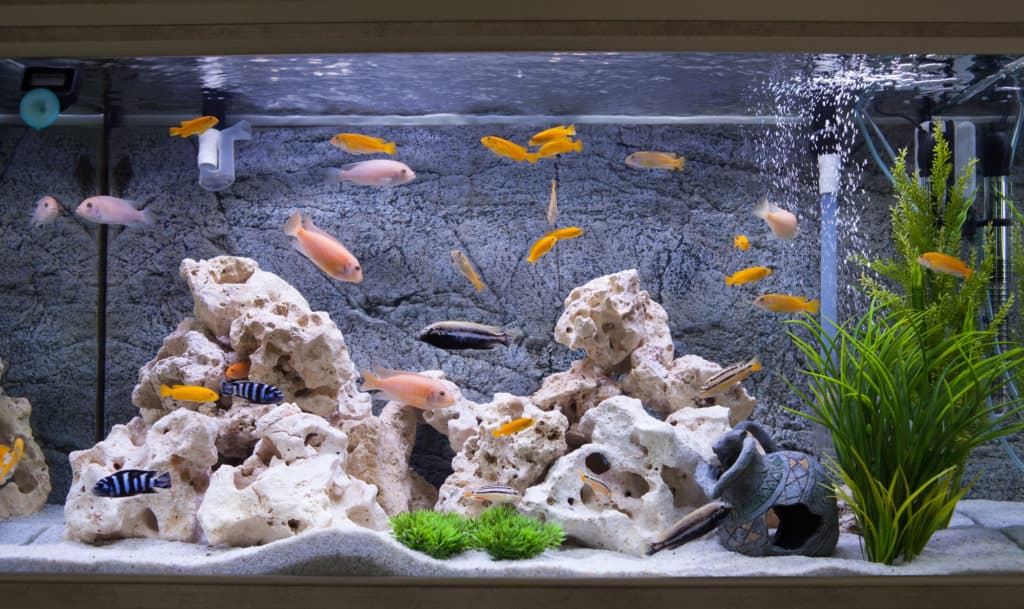
African Cichlids are gorgeous fish that have an amazingly wide variety of patterns and colors.
There’s one to go with any aquarium’s theme, and anyone watching them is sure to be dazzled.
There’s only one tiny snag: their aggression.
African Cichlids can have a hard time getting along with other fish—even those in their own species.
Which African Cichlids can be kept together?
Which Types of African Cichlids Can Be Kept Together
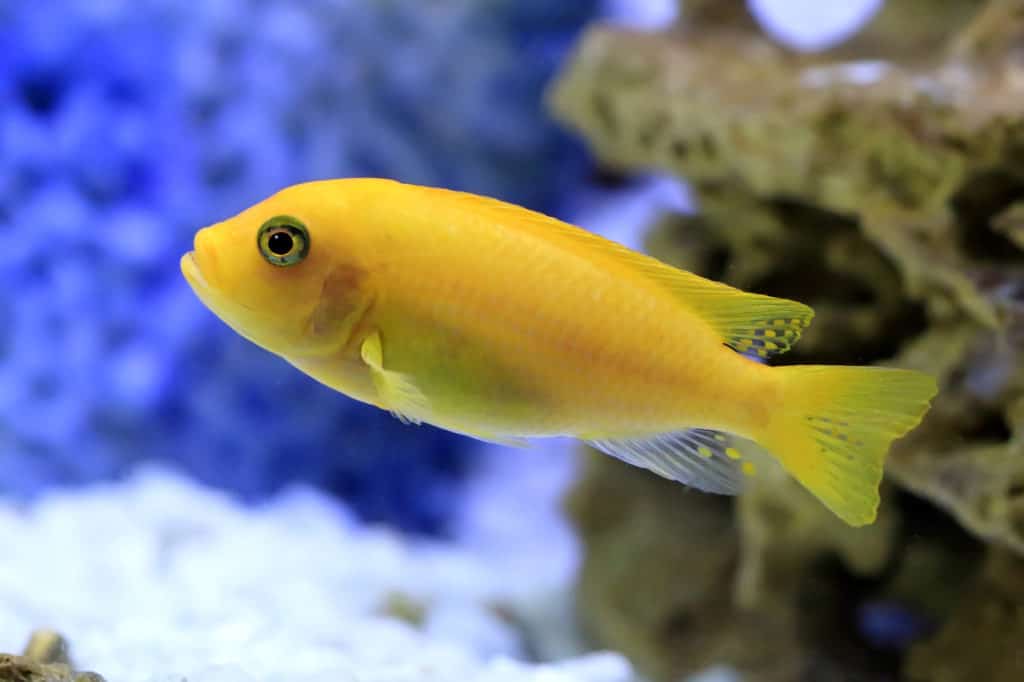
African Cichlids are a part of the Cichlidae family, which could include up to 1500 species—meaning you’ve got quite a few fish to choose from!
Many of those species can be found in Africa, South America, and Asia, though almost all African Cichlids live in one of East Africa’s three great lakes: Lake Victoria, Lake Malawi, and Lake Tanganyika.
These colorful beauties are also hardy.
They’re more likely to survive when rookie tank owners make common mistakes.
Sadly, however, no fish is without its flaws.
Most African Cichlids are too aggressive to be kept together in groups.
That’s not to say there’s no chance at all!
It is possible to house some species together.
Here are the rare few which should be fine to keep in the same tank.
1. Dwarf Cichlids
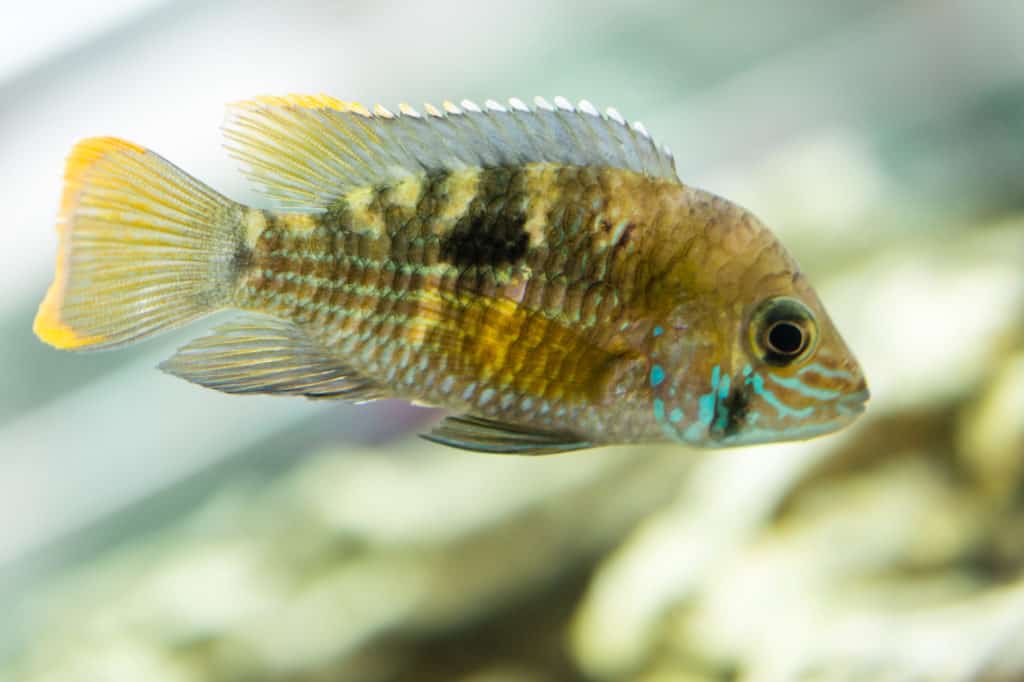
The first group you can keep together are Dwarf Cichlids.
They’re on the less aggressive side of the species and will be a little easier to keep together.
Dwarf Cichlids, when compared to their relatives from Africa, are a bit smaller, only reaching about four inches.
They do better in groups, but we can’t say that they’re entirely peaceful, either.
They can be prone to showing aggression, especially if you plan to breed them, so you should have more females than male fish in your tank.
One male for every three females should help keep the peace.
As for their habitat, West African Dwarf cichlids prefer a pH between 7 and 7.5 with temperatures between 78 and 84 degrees.
As for their diet, Dwarf cichlids will be generally easy to feed.
They can be fed insects, insect larvae, frozen brine shrimp, and crustaceans.
They’ll also do just fine on a diet of flakes and pelleted food.
2. South American River Cichlids
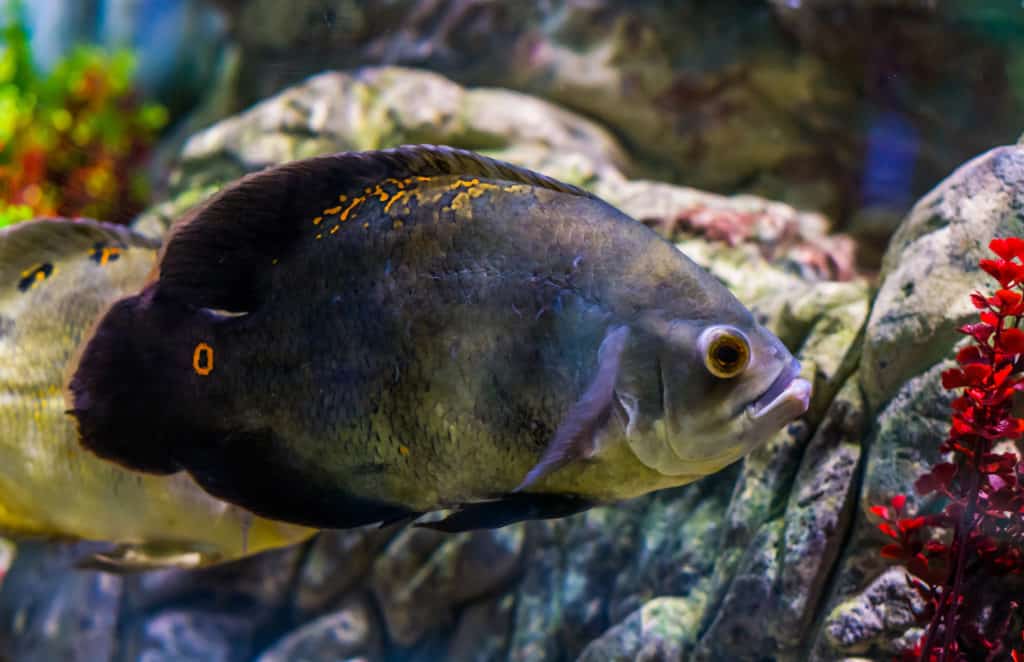
South American River Cichlids, also known as large river cichlids, are another species that can be housed together.
They’re far less prone to aggression and can even get along with other fish like Corydoras and tetras!
South American River Cichlids can be found in any of Africa’s three great lakes as well as the Amazon River.
These colorful fish can grow to be anywhere from 3–15 inches and live up to 20 years.
Be sure you’re ready for the commitment!
Their natural habitat is between 75 and 85 degrees, and their pH preference is between 6 and 7.5.
Like all other cichlids, they should have a fairly large tank.
A good rule of thumb to follow is to keep fish that grow larger than seven inches in a 50-gallon tank or larger.
Their diet is made up of live food like brine shrimp.
These fish are carnivores, like most other cichlids.
3. Peacock Cichlids
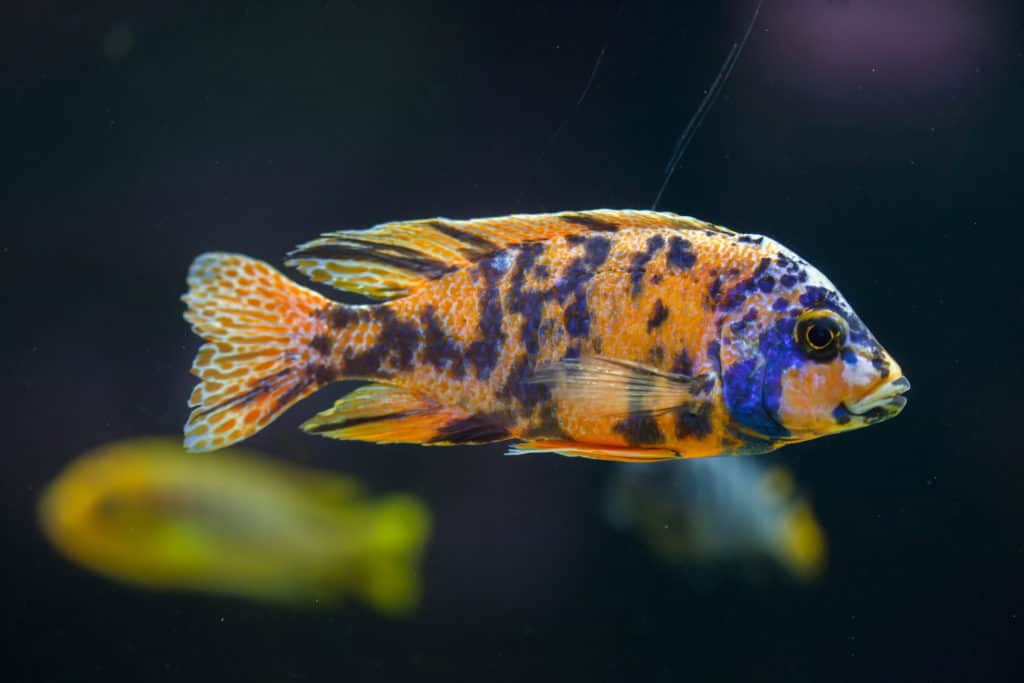
Peacock Cichlids are another species that are fine to live in groups.
While the males can be territorial, that can be fixed by giving them their own space.
When they’re kept in a larger tank, they’re less likely to be aggressive.
There are quite a few different types of peacock cichlids, the more popular including red peacock, OB peacock, and strawberry peacock cichlids.
The latter is somewhat difficult to find, but it’s well worth the search!
Native to Lake Malawi in Eastern Africa, these fish prefer warmer waters, with temperatures between 74 to 82 degrees.
If you can, try and keep the water closer to 80.
They like their water hardness between 4 to 6 dH, and a pH level between 7.5 and 8.5.
They’ve very active fish and spend a lot of their time near the bottom of their tank.
They can even have non-cichlid tank mates, too!
They can also be housed with other non-aggressive fish, as long as they can still have their own space.
4. Mbuna
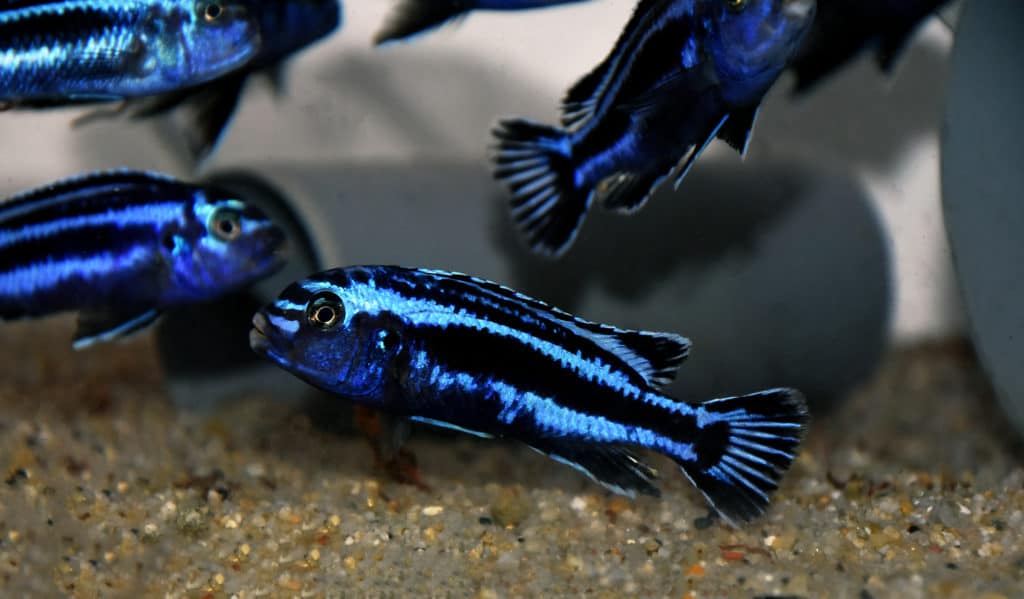
Another species that can be kept together are Mbuna.
Not only can they be kept in a community together, but they can be kept with other species as well, like peacock cichlids, for example.
These colorful beauties are from East Africa’s Lake Malawi, and their colors range from orange to yellow to blue.
These herbivores can reach up to five to six inches when kept in a properly sized tank with the right conditions.
They prefer a pH above 7.5, and temperatures between 75 and 79 degrees.
Just like the vast lake they come from, their tank should be taller and wider than your average aquarium.
Their diet in the wild consists of zooplankton blooms and aufwuchs.
Aufwuchs is a German word which boils down to meaning “surface growth.”
In captivity, Mbuna should have an algae-based diet to keep them happy and healthy.
If you’re looking to breed them, the proper breeding environment isn’t hard to achieve.
Just provide them with the same conditions as non-spawning Mbuna.
They spawn among rocks, and you can tell when they’re ready to spawn when you can spot a male “dancing” in the tank.
Males will wiggle their bodies and extend their fins, and when a female is impressed, the two will return to a chosen spawning site.
In about four weeks, you should have Mbuna cichlid fry swimming freely.
5. African Butterfly
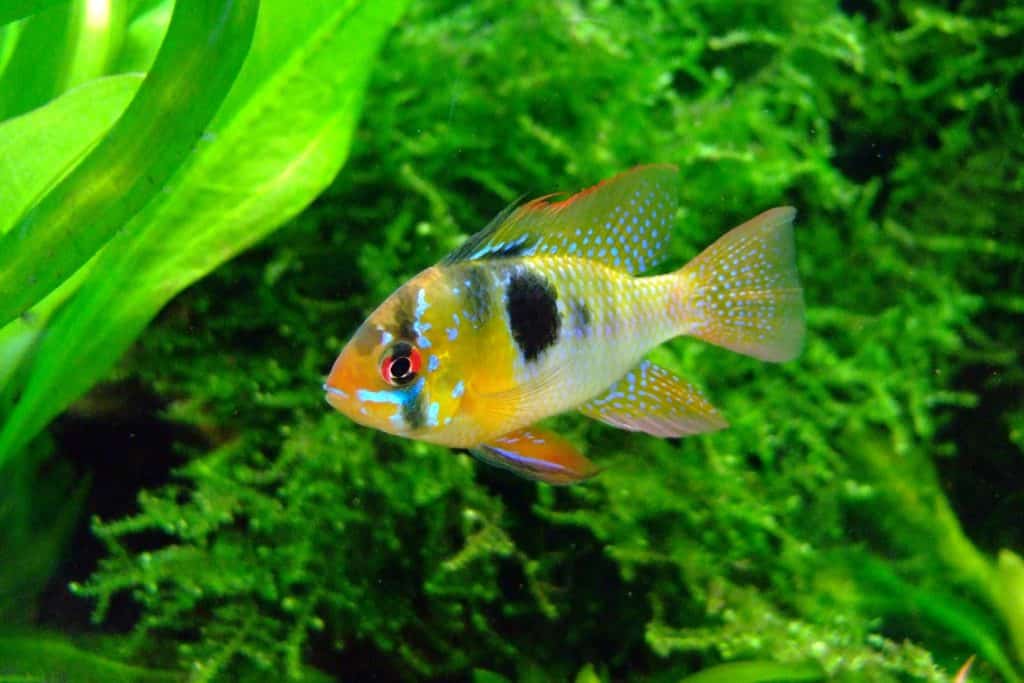
Another great type of African cichlid to keep together are African Butterfly cichlids.
Found in savannah wetlands and shallow forest streams, these stunning fish are on the smaller side, and look amazing in just about any tank setting.
These cichlids are shy, peaceful, and can be kept in groups of eight or more.
They can also be housed with a number of tankmates, including barbs, tetras, dwarf gourami, and more.
Their diet should consist of brine shrimp, bloodworm, mosquito larvae, and daphnia as well as a good flake or micropellets.
African Butterfly cichlids are also great for breeding—when given the right environment.
Once they’ve paired off, either they should be moved to a breeding tank or their tankmates should be moved for their own safety.
The breeding tank’s pH should be neutral or slightly acidic and full of flat rocks for your female to deposit her eggs onto.
They can lay about 500 eggs at a time, and they should hatch somewhere between 48 and 72 hours.
The parents will care for their fry for about four weeks, and after that point, they can be moved to another aquarium.
6. Electric Yellow Cichlid
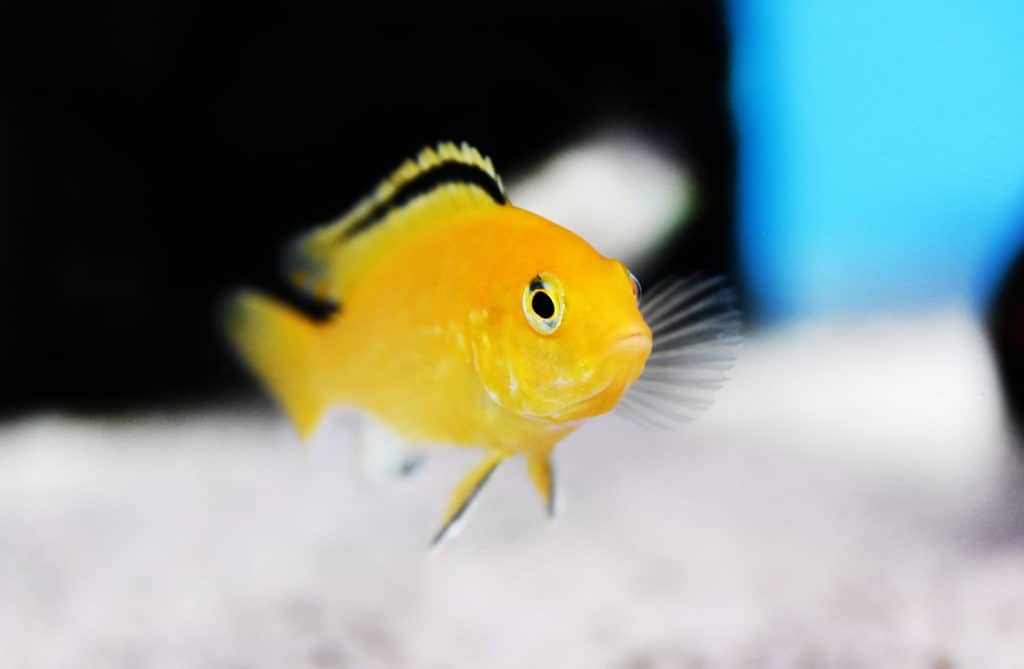
These peaceful fish are another bottom-feeder that can be kept in groups.
They can be found in Lake Malawi in deep, rocky waters.
Because they can be semi-aggressive, it’s best to keep three or more females per single male in your tank.
You should also make sure they have proper space.
If they’re too cramped together, fights can break out and get dangerous.
If you plan to give them additional tankmates, it’s best to house them with larger fish.
They won’t be seen as food or competition.
They’re omnivorous and should be fed a diet of both greens and meat.
This includes algae pellets and vegetable flakes, frozen bloodworms, larvae, and brine shrimp.
You can even occasionally feed them peas, lettuce, and spinach.
It’s common for these types of fish to breed in their tanks, too.
They can have anywhere between 10 and 30 fry at a time, which take about three weeks to hatch and become free-swimming.
7. African Orange Cichlids
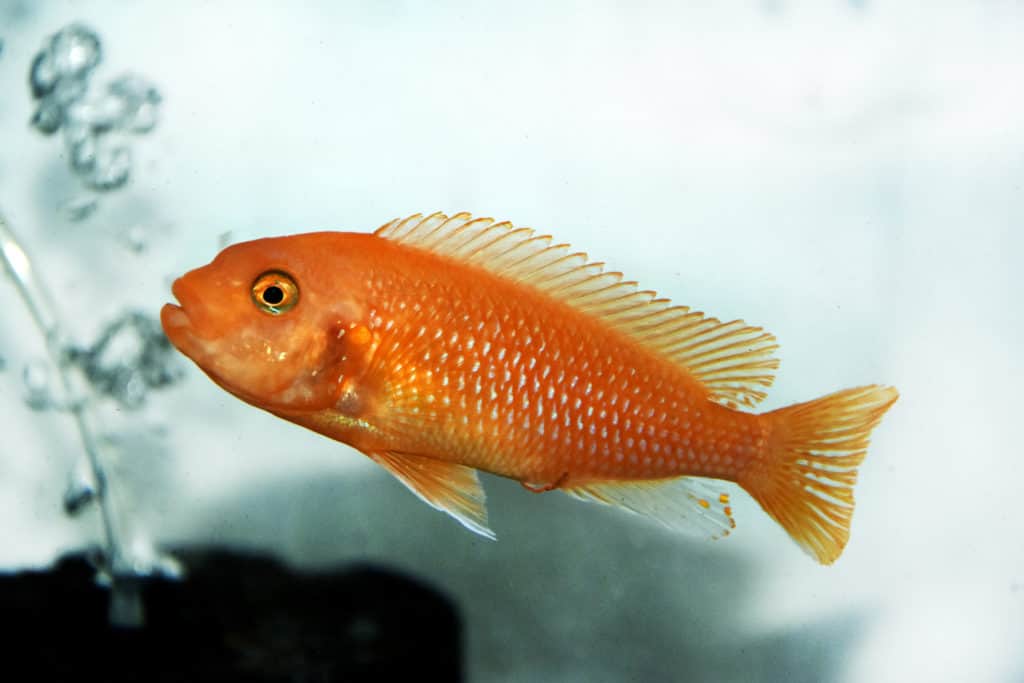
African Orange cichlids are another fish from Lake Malawi.
They are accustomed to open waters with rocky bottoms.
These beauties can be kept in a pair and need a tank of at least 35 gallons to thrive.
Remember, with cichlids, a tank on the larger side is always best.
Their preferred pH and water temperature is a lot like other cichlids from the same lake.
The temperature should be between 75 and 82 degrees, the pH between 7.6 and 8.8, and the water hardness should be somewhere between 10 and 25.
These types of cichlids are aggressive and should not be housed with peaceful cichlids like Utaka and Peacock if you plan on housing them in a community tank.
As for their diet, they should be fed mostly plant matter.
Feeding them nori and blanched spinach should work just fine.
You can also give them a little bit of frozen invertebrates as a treat, but never too much. If they digest too much meat, it can interfere with their digestion.
8. Electric Blue Haps
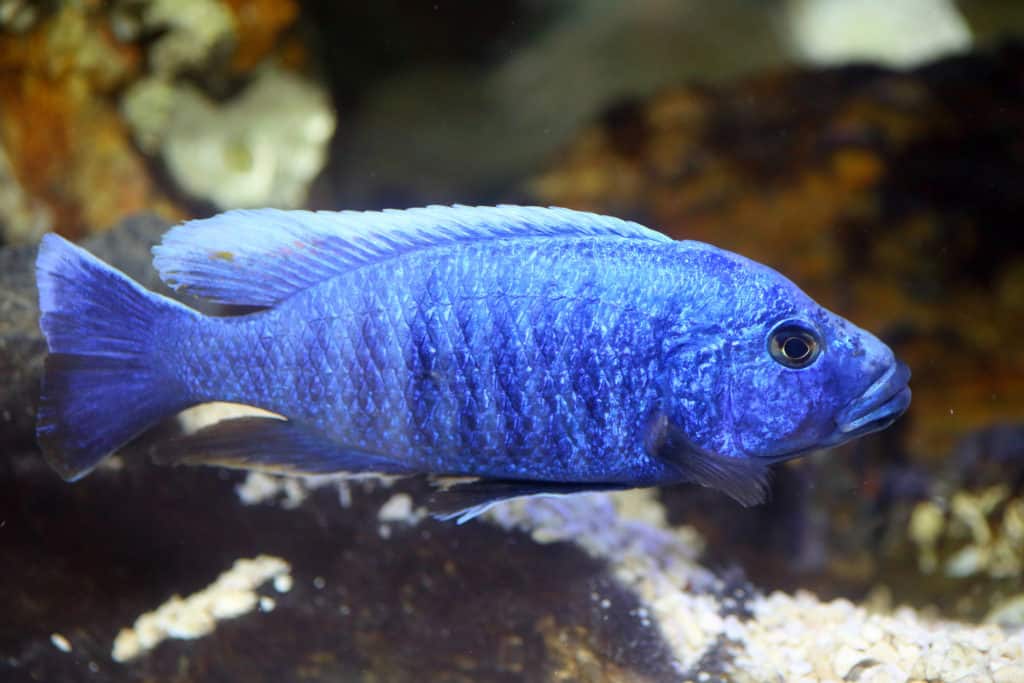
Another cichlid you can house together are electric blue haps.
They are, just like their name, a striking electric blue color with vertical stripes.
Females are slightly smaller and tend to be more silver and lighter blue shades than the males.
When housing them together, you shouldn’t have more than one male per four (or more) females.
It’s also best that you get all of them at the same time.
Males will try to defend their territory against all new fish, even if they’re of much larger size.
Their tank’s water should be hard and alkaline, with a pH of 7.7 to 8.6, and a water hardness of 6 dGH.
Their temperature should be on the warmer side—between 73 and 82 degrees.
Just like the other cichlids on this list, they prefer rocky terrain with lots of places to hide.
These cichlids are piscivores, meaning they eat fish.
They can be fed feeder fish and specially-made cichlid pellets and flakes as well as worms and shrimp.
It’s best to feed them small meals throughout the day to keep them from overstuffing themselves.
Breeding them is relatively simple.
The females will hold their fertilized eggs in their mouth until the fry hatch over the course of a day or two.
Then, after another three days, the fry will become free-swimming, and the mother will let them out of her mouth when she feels it is safe.
9. Buffalo Head Cichlid
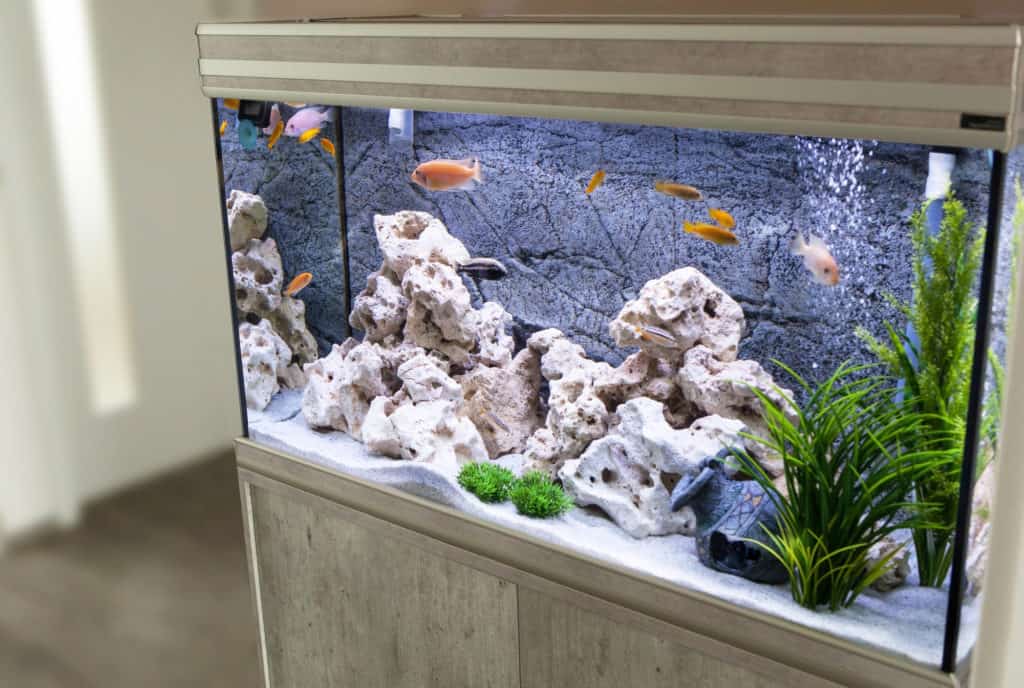
A final candidate is the buffalo head cichlid.
Also known as the lionhead, humphead, and blockhead, these unique fish are great for beginners or less experienced aquarists.
If you’re just starting out with African cichlids, this is the best fish to start with.
These omnivores are generally peaceful, except for when breeding or when feeling threatened.
They should be kept in pairs and can be kept in community tanks.
However, if they’re going to be living in a community tank, you should avoid housing them with smaller fish, other bottom-dwellers, and other cichlids aside from another buffalo head.
Their tank’s pH should be anywhere between 6 and 7.5, and the temperature should be on the warmer side—between 75 and 82 degrees.
They should also have lots of space to allow them to dig and create tunnels.
If you’re looking to breed them, you should know that the bond between them can grow so strong that if one in a pair dies, the other might not seek another partner.
It’s best to give them their own tank where they can spawn in peace.
Their fry will hatch in about five to seven days, become free swimming in 11 to 14 days, and will be guarded by their parents for up to three months.
How to House African Cichlids Together
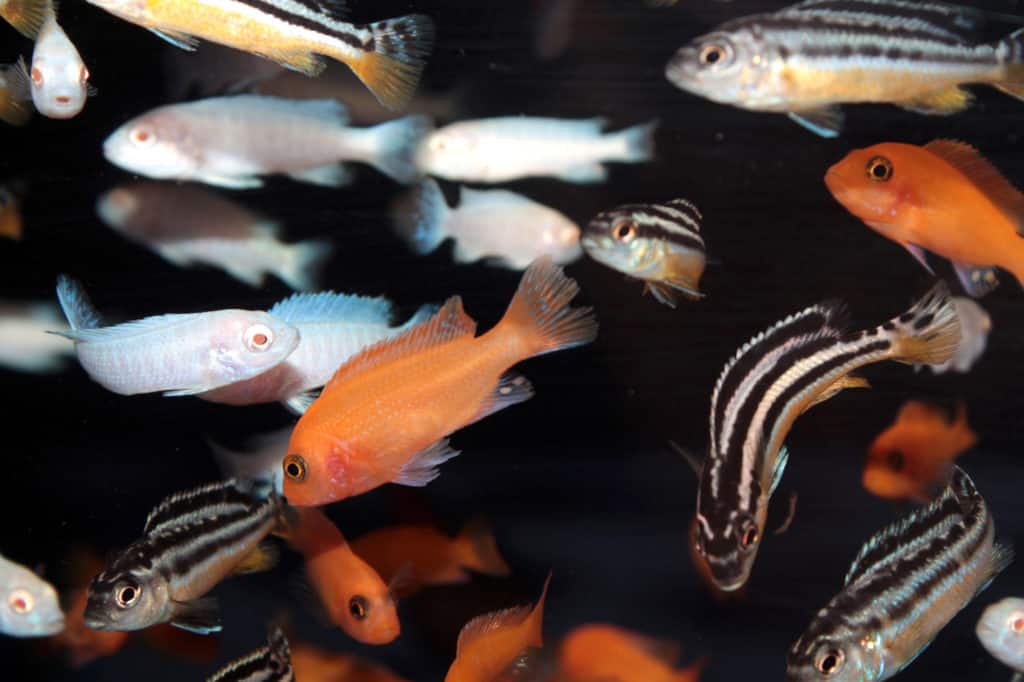
Before you put them in their tank, make sure their environment is set up properly, and make sure you have the correct male-to-female ratio.
Each fish has its own personality and temperament, so it’s best to keep a close eye on your fish as they adjust to their new home.
You should also make sure the proper pH, temperature, and water hardness is ready for them before they’re transferred to their tank.
Their Preferred Environment
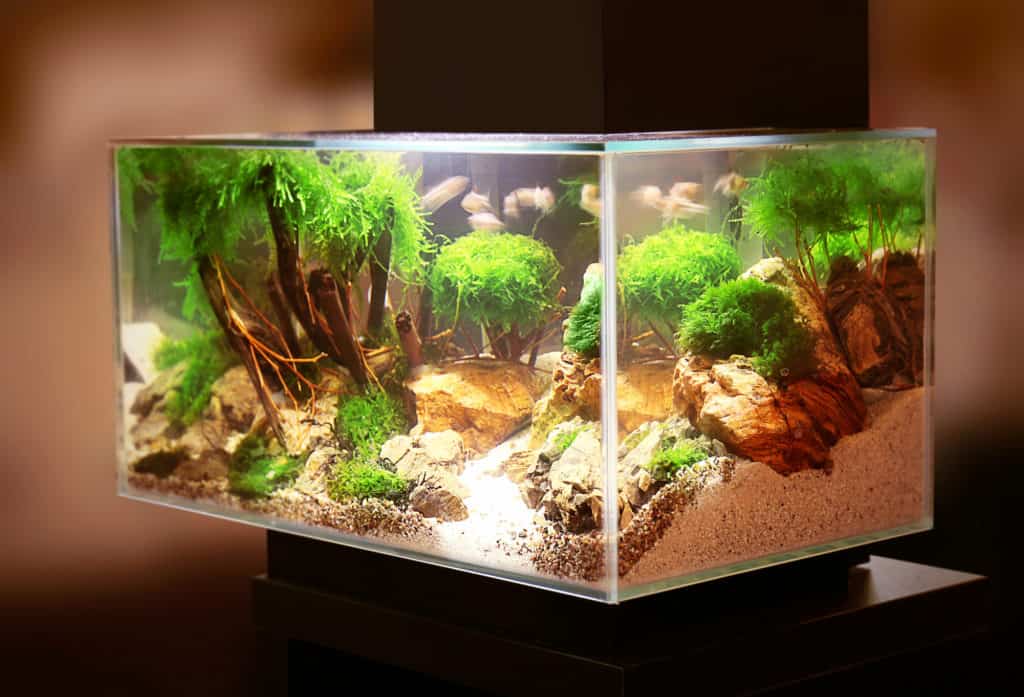
Like all fish, African Cichlids have a preferred environment.
This can vary from fish to fish, but there are some general tips that we have which should keep any African Cichlid happy.
Their tank, for starters, should be longer than it is tall, and they should have plenty of room to swim around.
If your fish are too cramped, it can increase tension and lead to fights.
They also enjoy rocky environments with lots of caves and places to hide.
The only thing you really have to keep in mind about their environment is that some African cichlids might dig up plants on the bottom of their tank.
Final Thoughts
Many African Cichlids can live together in harmony—when paired correctly.
Since there are so many different types of African Cichlids, matching them with other fish should be easy as pie.
It may take some trial and error, but you should know that it isn’t impossible to house African cichlids together.
With a little patience, things will work out and you’ll be left with a tank full of happy fish.
Here’s to hoping your fish get along and live long, happy lives together.
How are your African Cichlids doing together?
Do you have any tips for keeping the peace?
Let us know in the comments below.
We’d love to hear from you!
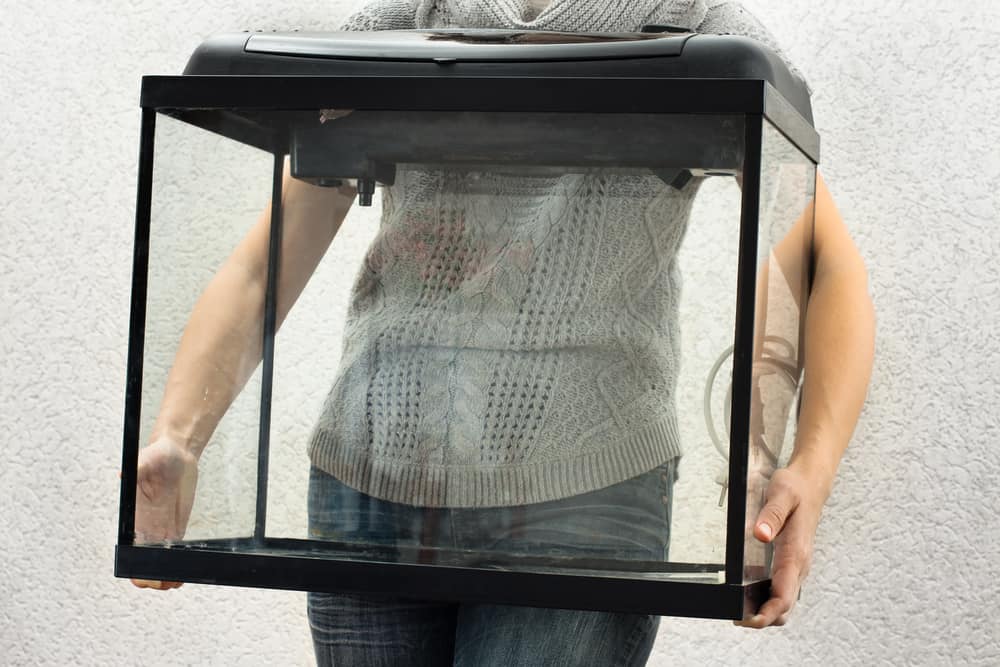
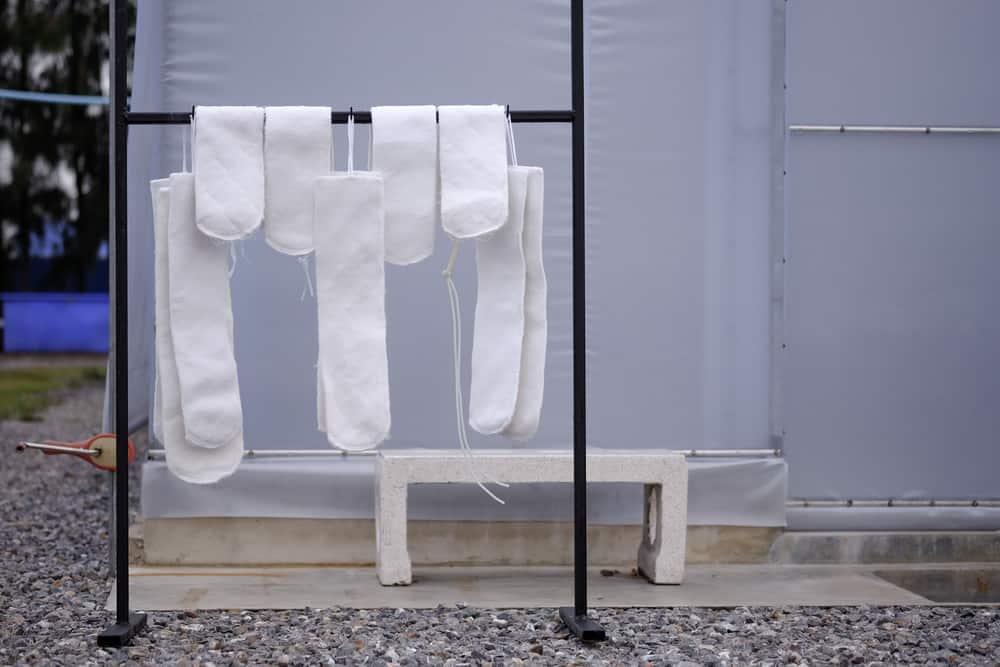
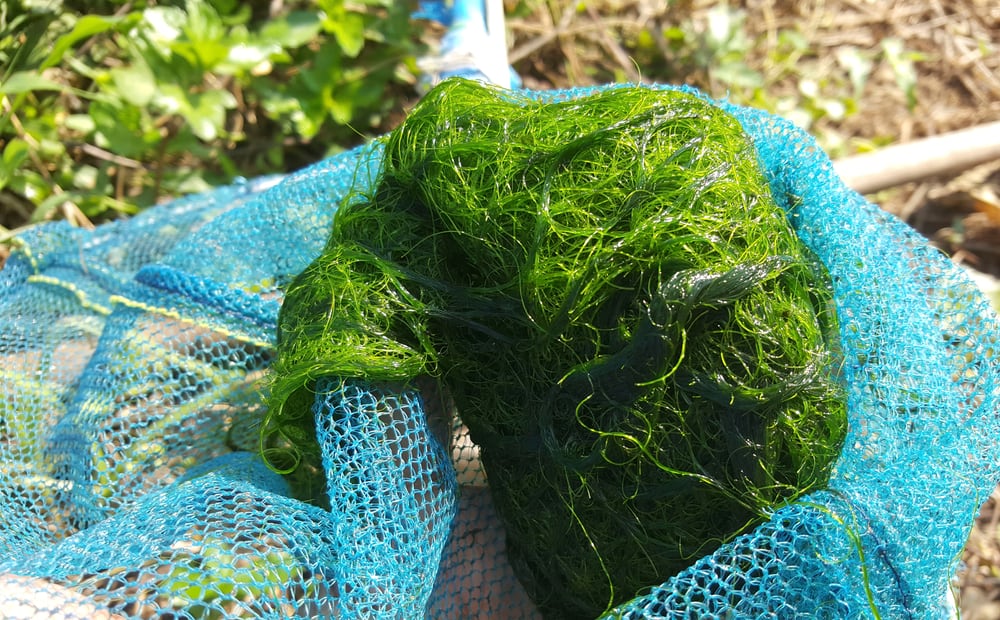
Leave a Reply